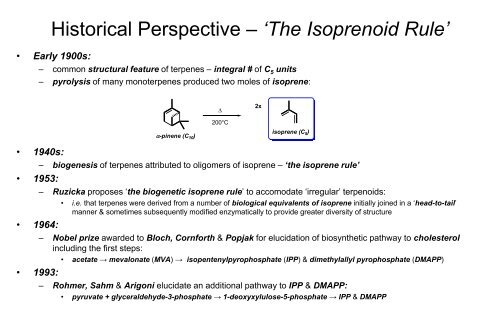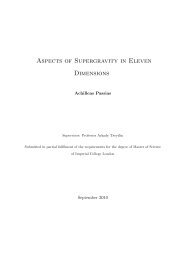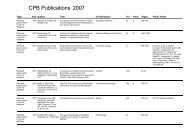lecture890708 - Workspace
lecture890708 - Workspace
lecture890708 - Workspace
You also want an ePaper? Increase the reach of your titles
YUMPU automatically turns print PDFs into web optimized ePapers that Google loves.
Historical Perspective – ‘The Isoprenoid Rule’<br />
• Early 1900s:<br />
– common structural feature of terpenes – integral # of C 5 units<br />
– pyrolysis of many monoterpenes produced two moles of isoprene:<br />
• 1940s:<br />
• 1953:<br />
• 1964:<br />
• 1993:<br />
α-pinene (C 10)<br />
200°C<br />
– biogenesis of terpenes attributed to oligomers of isoprene – ‘the isoprene rule’<br />
– Ruzicka proposes ‘the biogenetic isoprene rule’ to accomodate ‘irregular’ terpenoids:<br />
• i.e. that terpenes were derived from a number of biological equivalents of isoprene initially joined in a ‘head-to-tail’<br />
manner & sometimes subsequently modified enzymatically to provide greater diversity of structure<br />
– Nobel prize awarded to Bloch, Cornforth & Popjak for elucidation of biosynthetic pathway to cholesterol<br />
including the first steps:<br />
• acetate → mevalonate (MVA) → isopentenylpyrophosphate (IPP) & dimethylallyl pyrophosphate (DMAPP)<br />
– Rohmer, Sahm & Arigoni elucidate an additional pathway to IPP & DMAPP:<br />
• pyruvate + glyceraldehyde-3-phosphate → 1-deoxyxylulose-5-phosphate → IPP & DMAPP<br />
Δ<br />
2x<br />
isoprene (C 5)
















